Core Diagrams – A Design Language for Enterprise Architecture
In part 3 an operating model was selected based on a capability mapping of the business model design. In this article, a design language for creating an ecosystem to support the operating model will be covered.
Core Diagrams – Ecosystem Visual Modeling
Once the operating model is selected, a Core Diagram is produced that illustrates the platform ecosystem which delivers the capabilities needed to support the enterprise architecture. The Core Diagram’s main purpose is to graphically represent the systems capabilities and connectivity in a single, comprehensive reference. The Core Diagram is the blueprint that answers the question: “What does an enterprise architecture look like?” The Core Diagram components include the following:
- Core Business Processes
- Shared Data Driving Core Business Processes
- Key Linking and Automation Technologies
- Middleware
- Portals
- Integration Interfaces
- Employees
- Customers
- Partners
- Suppliers
- Key Customer Segments

Core Diagram Design Process4 (©2005 MIT Sloan Center for Information Systems Research and IMD)
Each type of Core Diagram can be designed using a process that is aligned with the characteristics of the operating model. In the example diagram above, the major activities in the process are indicated in the sequence in which they are performed. For instance, in the diagram, key customer segments are first identified so that the business processes that are to be standardized and integrated can be determined. Once these processes have been selected, the shared data needed to execute them is synthesized to develop into the Core Diagram information architecture. In the diagram, the technology and platforms enabling the standardized integration are optionally included in the model.
The visual model produced by the process is the Core Diagram that includes all the elements of an enterprise architecture that can be exploited as a robust foundation for execution. The Core Diagram becomes an essential reference for executive management when developing new business strategies and business model innovation ventures. The Core Diagram enhances strategic thinking for executive management by facilitating business creativity at a glance.
Coordination Operating Model – Core Diagram

Coordination Operating Model Core Diagram4 (©2005 MIT Sloan Center for Information Systems Research and IMD)
The Coordination Operating Model Core Diagram is designed by first considering the key customers shared among the business units in the enterprise. The business units in this case offer different products and services but all depend upon a set of shared data to deliver value to the customer segments. Business processes in the Coordination Operating Model are highly integrated since those products and services may involve transactions that span business units. The key objective is for each customer segment to have a cohesive experience across all the channels and relationships. The integration technologies and linked processes that enable these business processes are optionally included in the diagram.
To begin to understand the design of the enterprise architecture ecosystem, the table below maps out the enabling technologies and platforms that can be considered for each aspect of the operating model.
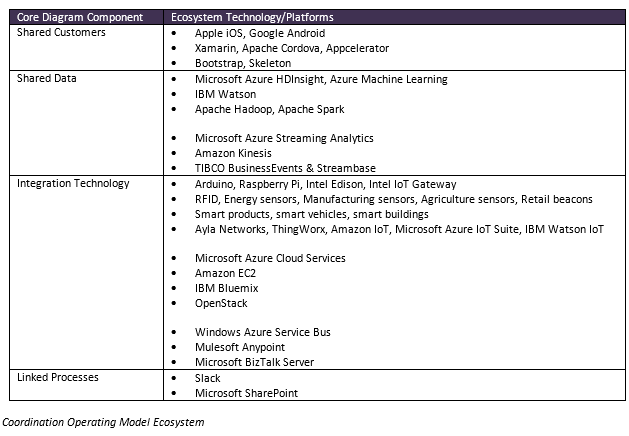
In this operating model mobile-first responsive design can play a major role in the implementation of the enterprise architecture capabilities. It is important for the shared customer segments to have a consistent yet context-driven presentation as they engage across the various interfaces of each business unit and channel using either an Apple iOS or Google Android device.
Big Data platforms, such as Windows Azure HDInsight or Apache Hadoop, are also key in this model since the volume, variety and velocity of shared customer-related data that is generated across business units and channels can be very significant. Developing sophisticated analytical capabilities such as machine learning algorithms can yield data insights over a large number of dimensions that can be capitalized on an enterprise-wide basis.
Being high on the integration scale, the operating model will have to make effective use of platforms that can create system linkages while enabling business process customization. Each business unit may execute a variant version of a business process that must be supported with agile and flexible integration platforms that can deliver data at high velocity. Some of the integration platform enablers include Mulesoft Anypoint, Microsoft BizTalk Server and Windows Azure Service Bus.

New Venture in Coordination Operating Model
The core diagram facilitates the envisioning process for how the new venture will be able to exploit the enterprise architecture to deliver on the business model innovation. Executive management can use the core diagram produced by the enterprise architects as a means to build shared vision with the intrapreneurs for how the venture will operate. The core diagram informs the innovation team how the venture would leverage shared customer data while creating the linkages via ecosystem integration platforms into enterprise resources and services, such as Big Data analytics.
Unification Operating Model – Core Diagram

Unification Operating Model Core Diagram4 (©2005 MIT Sloan Center for Information Systems Research and IMD)
The Unification Operating Model is designed by first identifying the key customer segments or channels that need to be served. The enterprise architecture team along with executive management work to select the key standardized processes that should be executed on a consistent and scalable basis throughout the business. The processes may be defined around core competencies by which the enterprise delivers value to the customer segments. The processes are dependent on a set of common master data that are used across coordinated high-velocity transactions. This type of operating model is especially well-suited to respond to customer and channel events in real-time to enable the OODA loop to power the collaborative decision-making within the enterprise. The technology ecosystem to support this operating model consists of a standardized set of integration technologies and platform capabilities that exhibit robust reliability and high scalability.
For customer segments, the key to delivering exceptional experiences across relationships and channels is the architecture’s ability to scale elastically as the core business processes and their associated workflows are performed. Moreover, the interfaces to these customer segments should be addressed with a mobile-first driven design to facilitate a consistent, context-driven interaction with the core standard processes. These interfaces enable communication of real-time open world events into the operating core and the response must be presented reliably throughout each process.
The elastic computing necessary to support standardized core processes can be achieved via cloud-based integration platforms such Amazon EC2, Microsoft Azure, or open-source platforms such as OpenStack. The economic justification for considering these options are based on the fact that capital expenditures related to additional data center capacity need not be incurred to deliver the service level outcomes desired by the enterprise. During peak periods, cloud computing resources can scale to meet the event-based transaction processing to ensure the customer experience is smooth and seamless as they engage in the various relationships and channels.
To surface the standardized business process, enterprise portals provide the collaborative capabilities to perform them in a consistent and repeatable manner. Microsoft SharePoint is designed especially well for this enablement since it also includes social networking features built on a Microsoft Azure cloud infrastructure. The Microsoft SharePoint platform also provides rich support for incorporating shared enterprise information in collaborative workflows. Slack is also a viable platform for enabling rich collaborative processes with robust integration capabilities to enterprise resources. These platforms help address the emphasis in the Unification model on creating highly collaborative environments to enable scalable processing as well as group-based decision modeling.
Shared data in this operating model, as in the Coordination model, also introduces an emphasis on Big Data technology and platforms due to the volume, variety and velocity by which the data can be generated and collected throughout the enterprise. The centralized data aspect to the Unification model prioritizes the need to create a solid foundation for advanced analytics such as classification, regression and prediction to support integrated decision modeling. Apache Hadoop and Windows Azure HD Insight are two platforms that serve as viable candidates for these capabilities in the operating model to support Big Data.
The table below illustrates the ecosystem technology and platform emphasis mapping for each aspect in the Unification Operating Model.
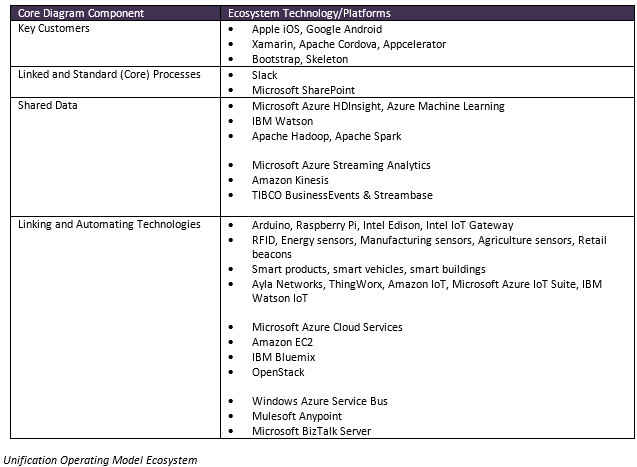
A new venture can fully exploit the scalability offered by the Unification Model by incorporating the standardized processes and integration interfaces into its business model. Enterprise architects use the Core Diagram to illustrate the business agility to intrapreneurs as well as executive management and to create a shared vision of the specialized processes and integration needed to support the innovation at the edge of the enterprise.

New Venture in Unification Operating Model
Diversification Operating Model – Core Diagram

Diversification Operating Model Core Diagram4 (©2005 MIT Sloan Center for Information Systems Research and IMD)
The Diversification Operating Model places the emphasis on the shared technology and platform stack instead of business process standardization and integration. To begin designing the Core Diagram for a Diversification model, the shared technology architecture services are identified then the corresponding platforms are selected. The business units in this type of enterprise can then leverage the shared services to execute highly specialized business processes to deliver value to their specific customer segments. The business units also own the data to serve their customer segments lowering the need for a common master data set. However, the design of the operating model can allow for a common set of business processes that can be leveraged and then customized by each business unit.
In this type of operating model, the technology and platform stack needs to have a flexible foundation for business process agility so that each business unit can perform their customizations. Integration platforms, such as Windows Azure Service Bus, Mulesoft Anypoint and Microsoft BizTalk Server, which support business process and workflow design, can serve as the enablers for this capability in the stack. Enterprise architects can work with business process owners in the business units to deliver the particular integrations and system linkages with customers and partners for execution based on the common integration platforms. The custom business processes may leverage features such as message-based routing, service brokering and transformation services in these platforms. It should be noted, however, that business units can make decisions to deploy other platforms based on their specific integration needs.
To surface the set of shared business processes available to the business units, enterprise collaboration portals like Slack and Microsoft SharePoint, can address this aspect of the operating model. Business units are free to design the information worker experience using these portals to perform the specialized business processing activities. In fact, using a composite application design approach, common enterprise services may be used to develop flexible and adaptable user interfaces tailored specifically to the information worker needs in a given business unit. Virtual teaming is another important service provided by these platforms that enable mobilization of individual resources with the required skillsets to execute a specialized process. The ability to search and discover the information worker resources available with a given skillset profile allows business units to focus on producing and maintaining the data to optimize virtual team formation.
The table below shows the ecosystem emphasis mapping to each aspect in the Diversification Operating Model. The Core Diagram is designed to illustrate how this mapping is manifested in the enterprise architecture.
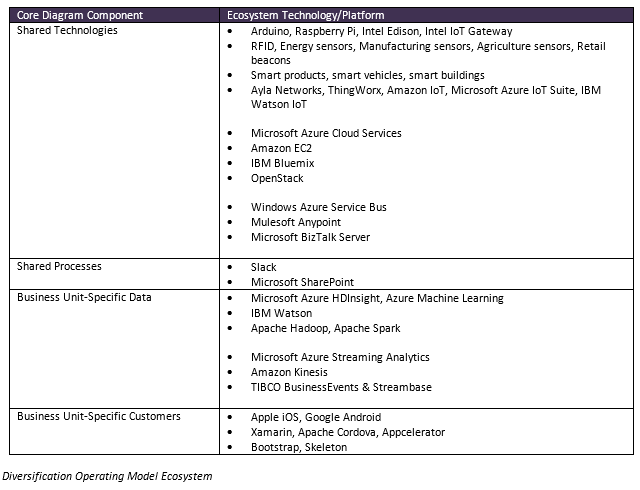
In the Diversification operating model, the shared services are exploited by the new venture in business model innovation. The new venture can be accelerated by developing specialized business processes to deliver value to its specific customer segments using the foundational technology stack. The new venture can focus on proving out is business model without the need to deploy the pre-requisite technology infrastructure. In fact, in this operating model, using a common collaboration platform can facilitate the mobilization of information worker resources from established business units into the new venture. Information workers familiar with the user interface can more readily execute the specific activities involved in the new processes.
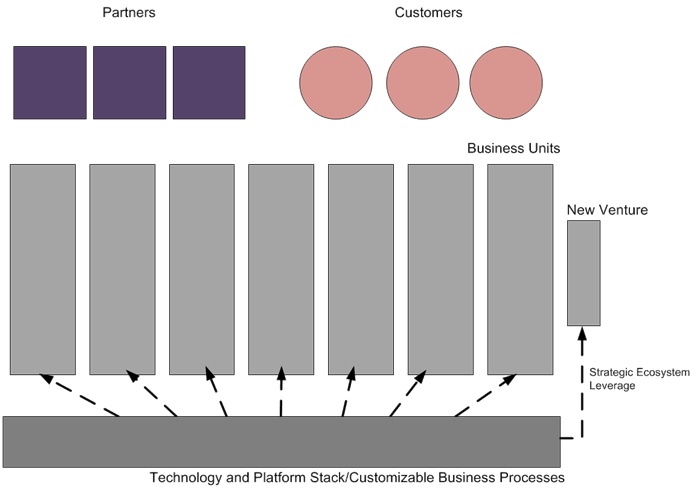
New Venture in Diversification Operating Model
Replication Operating Model – Core Diagram
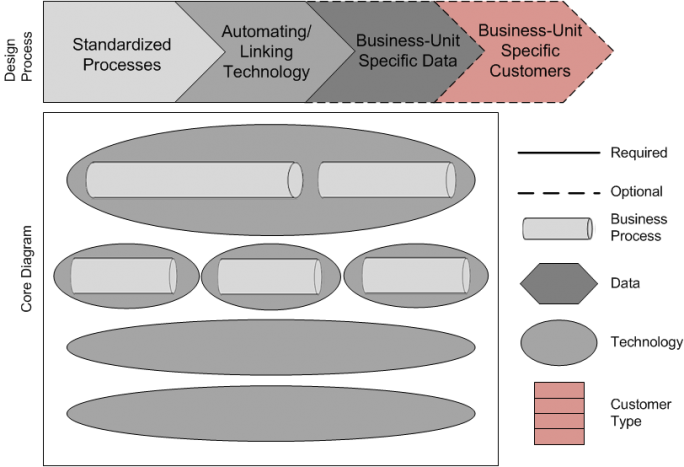
Replication Operating Model Core Diagram4 (©2005 MIT Sloan Center for Information Systems Research and IMD)
The Replication Operating model emphasis is on business process scalability and accelerated time-to-market for new ventures. The design of the Core Diagram begins with the identification of standardized business processes that are to be executed by any new ventures in business model innovation. Business modularity is a key characteristic of this operating model. The business processes are designed by a centralized team which may include enterprise architects and executive management. This operating model is advantages where business units need to be deployed rapidly on a global basis but need to maintain consistency with other parts of the enterprise to capitalize on established business model components in new contexts. The autonomous nature of business units in this operating model is also advantageous in the global environment. The supporting technologies and platforms used to automate these standardized business processes are then identified and bundled to facilitate planning and deployment when a new venture is formed.
In this operating model, predefined business processes can be enabled using enterprise group collaboration platforms such as Slack and Microsoft SharePoint. Packaged workflows and group workspaces or sites can be created to be deployed and operated in an independent manner in each business unit. In essence, these deployments are of turnkey collaboration solutions that can then be customized to meet the specific needs of the business unit in its operating context or region. These technologies and platforms automate business processes that are known to be efficient and profitable so the top line benefits to the enterprise can be significant from an investment perspective. The business modules and associated packaged deployment reduces risk and accelerates the time-to-value for the enterprise when a new venture is launched.
In addition to the portal interfaces in these bundled solutions, the underlying integration technologies that facilitate the linkages between internal systems and external services are also included as part of the automation deployment to support the standardized processes. Platforms in the ecosystem that can serve these purposes are Windows Azure Service Bus, Microsoft BizTalk Server as well as Mulesoft Anypoint. Components representing the codification and encapsulation of the business modules can be developed in either Mulesoft flows or BizTalk Server applications. Deployment in a specific business unit will involve following a standard procedure with configuration management reflecting the specific business unit IT environment. Windows Azure Service Bus can be used to enable linkages between business units, partners and channel service interfaces. Hybrid solutions could play a major role in these deployments since the business units need to exploit a federated infrastructure for autonomous operation. Considering Azure Service Bus also enhance ability in the enterprise to perform global class deployments for new ventures.
The table below indicates the ecosystem technology and platform emphasis mapping to the Replication operating model design aspects. Note that the ecosystem components that are directed at the business unit level are also mapped in the table to illustrate the relationship in the enterprise architecture.
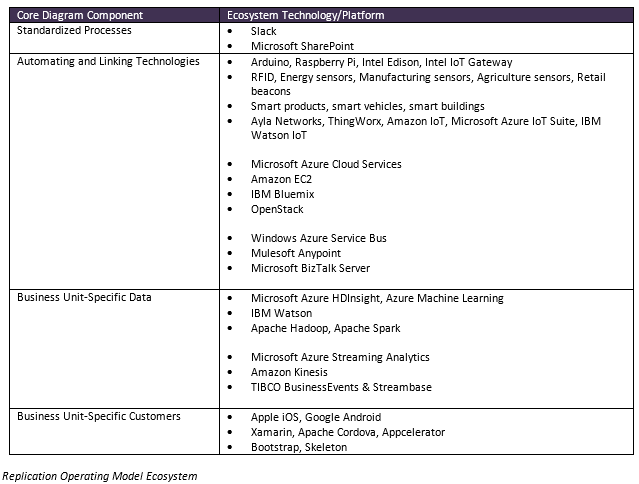
New ventures in the Replication Operating Model can be deployed globally in accelerated fashion by exploiting the business process modularity and turnkey solutions used for automation and integration. In this scenario, enterprise executives are adapting a successful and profitable business model to capitalize on opportunities in new markets using a very similar value proposition, or product-service market fit. Intrapreneurs in business model innovation can also analyze how these solutions can be adapted to ensure success within the specific context or region the business unit will be operating. Enterprise architects can then work together with the intrapreneurs to identify linkages across business units that may be necessary to coordinate federated business processes.
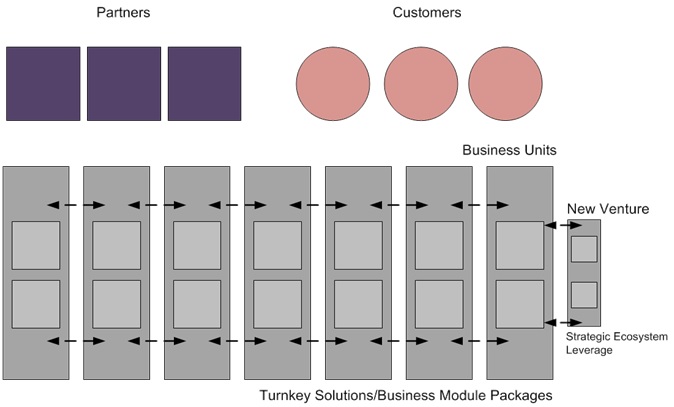
New Venture in Replication Operating Model
In the final Part 5 of this Business Model Innovation Series, a customer-centric methodology for measuring innovation will be presented. The empirical approach to determining effectiveness of the new design will drive pivot enhancements to guide the evolution of the new venture to increase potential of an optimal trajectory for growth.
References:
- The Business Model Innovation Factory: How to Stay Relevant When the World is Changing, Saul Kaplan, Wiley Press, 2012
- Alexander Osterwalder (2004). The Business Model Ontology – A Proposition In A Design Science Approach. PhD thesis University of Lausanne.
- Business Model Generation, Alexander Osterwalder, Yves Pigneur, Wiley Press, 2010.
- Enterprise Architecture as Strategy: Creating a Foundation for Business Execution, J. Ross, P. Weill, D. Robertson, Harvard Business School Press, 2006.
- USAF Colonel John Boyd, briefings on military strategy. (http://en.wikipedia.org/wiki/OODA_loop)
- Reinventing Your Business Model, Clayton M. Christensen, Mark W. Johnson, Henning Kagermann, Harvard Business Review, December 2008.
- Creating Value Through Business Model Innovation, Raphael Amit, Christoph Zott, MIT Sloan Management Review, Spring 2012 Vol. 53 No. 3.
- 2012 IBM CEO Study, Leading Through Connections, IBM Corporation.
- Change by Design: How Design Thinking Transforms Organizations and Inspires Innovation, Tim Brown (IDEO CEO), HarperBusiness, 2009.
- The Storm of Creativity, Kyna Leski, MIT Press, 2015
